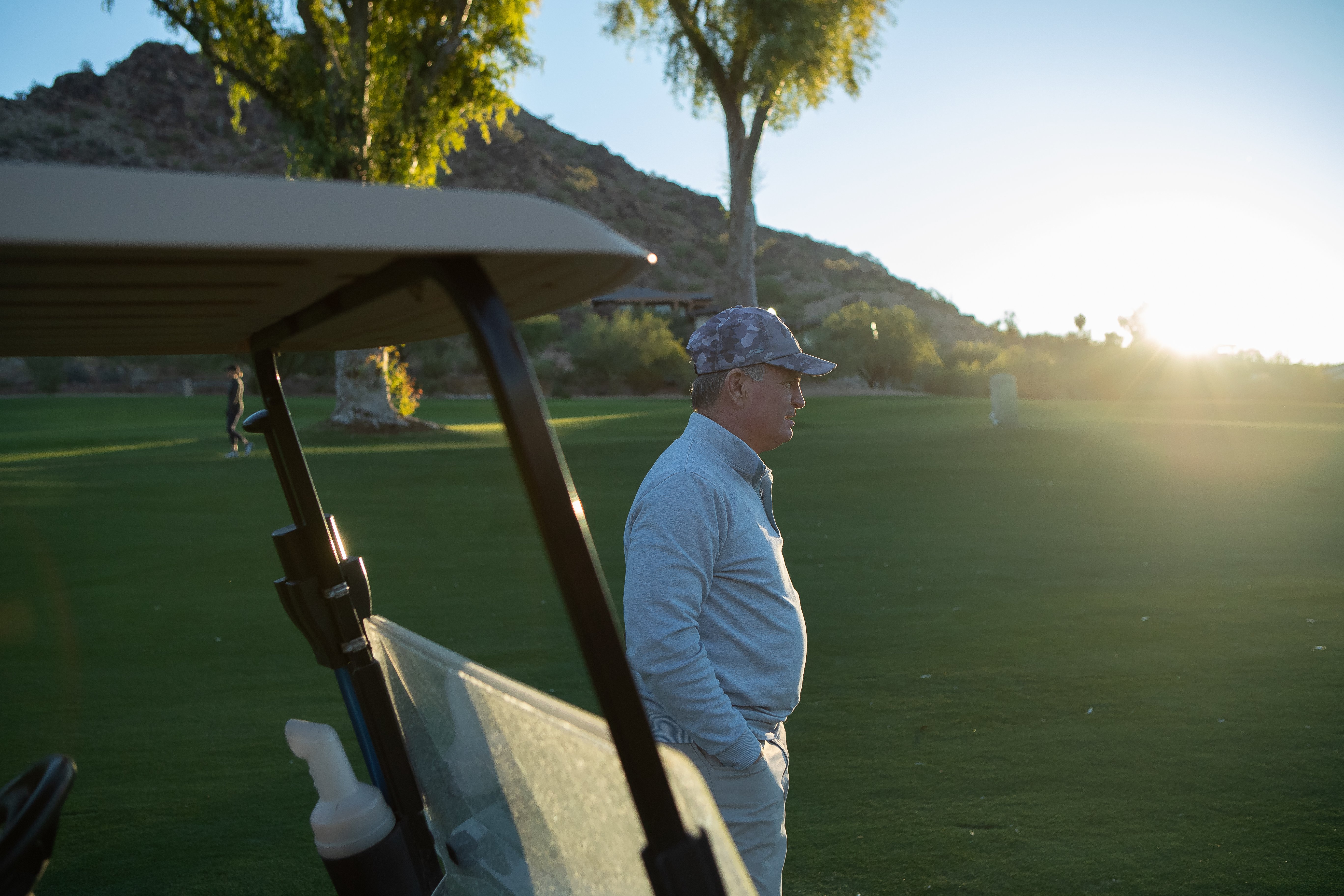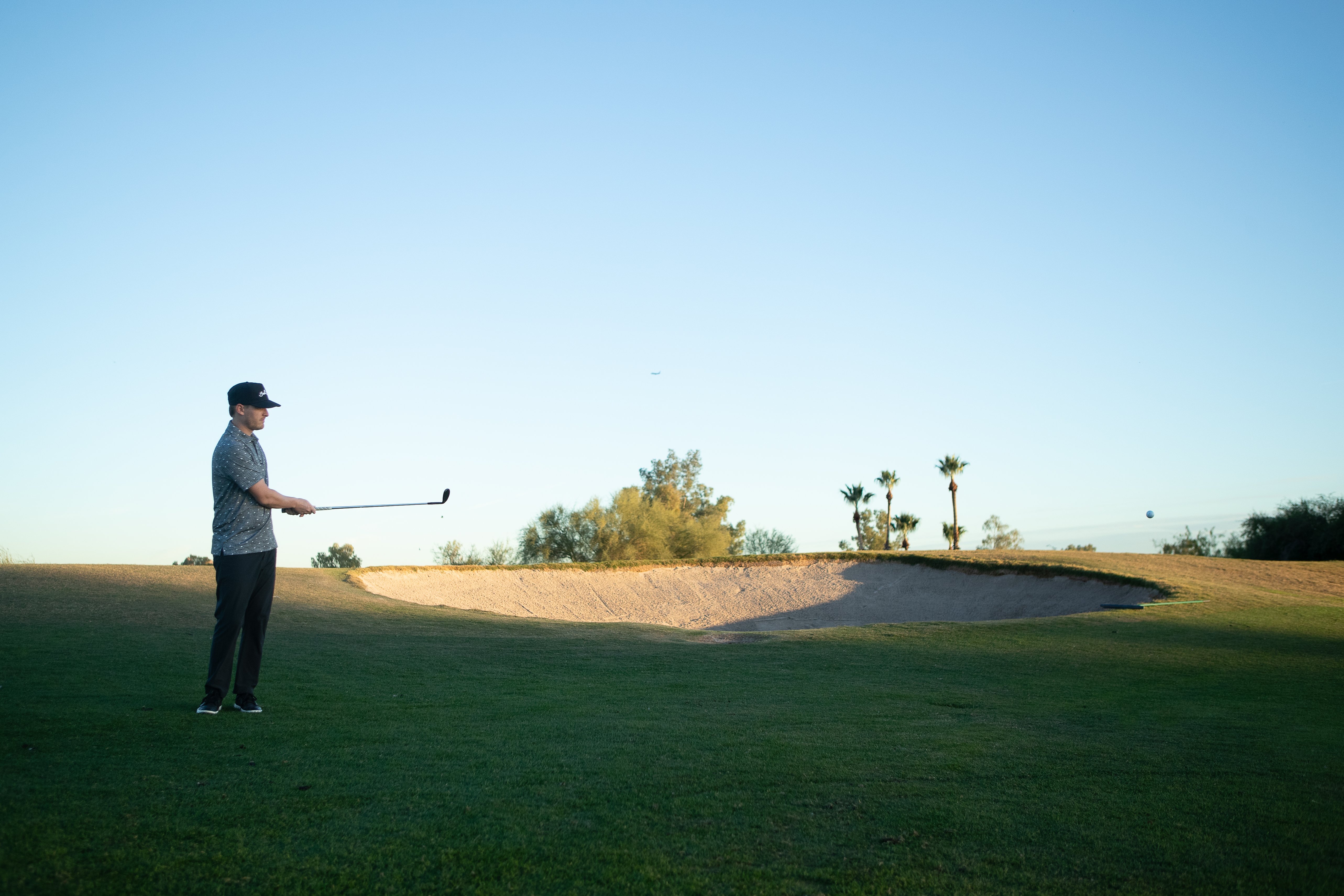It's Complex
(Featured Image by Josh Hanson) There are only two parts of a golf course every player is destined to put their spikes—the tee box and the...

For sustainability, there is no one ace in the hole
Above Image: Hole #18 at Desert Highlands Golf Club (Photo by Alex Johnson)
Like most golfers, when Trevor Faylor rolls up to a tee box, takes a practice swing or two, and prepares to begin a round of golf, he hopes the conditions of the course play to his favor. And he hopes they match the spiked greens fees, especially as Arizona becomes a mecca for exceptional winter golf.
“All anyone ever wants is good playing conditions and consistency,” Faylor said.
Faylor is an amateur golfer who lives in Queen Creek and plays up to eight times a month, but his take on ideal course conditions is echoed across all levels of golf management, from superintendents to agronomy teams. And as Arizona and other western states navigate dwindling water availability, courses across the region are looking for ways to maintain consistency of play while integrating more sustainable water management practices.
Joe Foley, the Arizona Golf Association’s executive director, knows different approaches are being tested across the Valley at both public and private courses that could increase the number of available golf days, reduce water use, and potentially improve the course’s ecosystem as a whole.
“What courses are doing now, they are doing a really good job of researching different grass types that are drought resistant and exploring conversations with members and resort guests around what is the value of playing ryegrass versus bermudagrass,” Foley said.
When it comes to water usage and sustainability, turf looms large.
Impending changes to water allotment policies, in addition to a desire to uncover sustainable practices that work for the environment and the club, are inspiring innovative trials at clubs across the valley.
At Desert Highlands Golf Club in Scottsdale, superintendent Curtis Tyrell has literally been watching grass grow for the past four years. It’s part of a trial the private club is doing to see if a new type of turf performs to expectations, while also eliminating the need for overseeding.
“The primary purpose of our trial is the pursuit of excellence,” Tyrell said. “We think we’ve found something that may be able to achieve that, and provide a tremendous amount of benefits from an environmental and sustainability standpoint.”
A water-intensive process, overseeding makes many courses unavailable for play for most of October - just as summer temperatures start to break. A future Arizona fall without overseeding, at scale, would be a monumental change
“If I have to convert the crop twice a year, I don’t get a lot of real sustainable, long-term system-building. I’m just constantly changing,” Tyrell said of the way Arizona golf turf has been managed for decades. “But, if I could grow one grass and cultivate the plant soil system and microbiology, I could build a plant system that is really more durable.”
Those long-term gains, which include better drought tolerance and improved operational efficiencies, are among the benefits of Zoysia grass - a turf the club has been testing with increasing acreage over the past four years. It stays greener longer and its density is agreeable for players like Faylor, who take notice of how clubs react in different types of turf.
 (Photo by Alex Johnson)
(Photo by Alex Johnson)
“As a player, ultimately what we get is a very upright lie. The ball sits on top, almost like it’s on a tee,” Tyrell said, noting that the structure of the blend they’re using has an enhanced rigidity. “If we can improve the surfaces, add to our available golf calendar, and decrease watering by not overseeding, and our surfaces were the best in the state, then we’ve really won.”
Paradise Valley Country Club is also in the midst of a turf trial, in cooperation with the USGA, with the same type of grass. Rob Collins, the club’s director of greens and grounds, has a similar optimism about Zoysia’s stadium blend. Collins said he is impressed with how quickly it grows as compared to bermudagrass, he appreciates its durability and resiliency, and he’s a fan of the potential it possesses for water reduction.
“It’s a really great grass. It’s very resistant to divots. It’s very durable. You don’t get a bounce off of this turf. It gives, but it doesn’t destroy the turf,” he said, noting its playability and conceding that despite its benefits, the jury is still out on whether Zoysia is a long-term substitute for bermudagrass. “I think what it really comes down to is widespread acknowledgement that there’s a water crisis and there’s likely going to need to be an alternative to overseeding.”
Bri Kenny, Troon Golf’s manager of environmental science, has been working with clubs to see down the fairway a bit on the issue of water use mitigation. On any given day, she can be knee-deep on regulatory issues, hazardous waste compliance, agronomy-related projects or initiatives that intersect with wildlife management. But water use is a priority, and efforts to minimize it go beyond planting new types of grass.
“Really, turf removal is the biggest way you’ll save water,” she said.
Data cited in a report prepared by the Arizona Alliance of Golf shows that the state’s golf industry is responsible for about 2% of water use statewide. Regulations over the years have progressively scaled back the acreage permissible for courses, and water allotments on an acreage basis have decreased over time.
In response, some courses are testing or replacing turf - like Alta Mesa Country Club’s complete transition to TifTuf, a bermudagrass blend that doesn’t require overseeding - some are removing turf and others are implementing other technologies. From updated irrigation systems with centralized control and a water station to moisture meters and wetting agents, Kenny said she works with courses across the Valley to find solutions that optimize water use while maintaining the quality of the experience that golfers have come to expect.
“People assume golf courses aren’t doing anything and they’re holding on to as much water as they can and they’re not willing to find solutions,” Kenny said. “The public just doesn’t know what superintendents are doing to try to fix it.”
The investment in water-saving solutions goes beyond the actual course, too. Matteo Serena is the USGA’s senior manager of irrigation research and services, a position that was newly created as part of the organization’s $30 million commitment to drive down golf’s use of water over the next 15 years.
Serena, who is working closely with Collins on the turf trial at Paradise Valley Country Club, is focused on marrying the academic research being done in university labs with actual implementation on courses across the country, but most specifically in the southwest. He said he’s seen a higher demand for change when it comes to water conservation on golf courses in recent years.

Rob Collins, Golf Course Superintendent at Paradise Valley Country Club (Photo by Alex Johnson)
“It’s partially driven by regulation, but also members are becoming more aware and they’re demanding more sustainability. There’s definitely been an awakening,” Serena said, noting that innovation isn’t always an attractive option because it doesn’t come cheap. “It takes time and money. You can’t flip a switch.”

Local-Arizona golfer Trevor Faylor (Photo by Alex Johnson)
Costs certainly loom over the issue, from greens fees to investing in new turf or technology to the cost of sitting tight as water availability becomes increasingly scarce. While applauding the many water conservation efforts Arizona’s golf industry has implemented in the decades leading up to this point, Foley also understands the future of the industry requires further exploration into new practices.
“We’ve been able to incorporate very golf industry-friendly stipulations within the management plan to make our sport continue to be viable, and also allow for us to make headway along the research front, turf management front, and turf reduction front, and also not to completely blow up the whole framework,” Foley said. “It’s really on the industry right now.”
The downstream impact of water conservation efforts across the golf industry has the potential to ripple through increased course availability in the absence of overseeding, financial savings with reduced water usage, and - for the average golfer like Faylor - a potential savings on greens fees, down the road.
“Ultimately, if an agronomy team is able to efficiently manage a course in terms of water and reduce costs there, hopefully it is reflected through greens fees,” Faylor said. “If there’s anything that can be done on the back end to reduce costs and lower the barrier of entry, that would be great.”

(Featured Image by Josh Hanson) There are only two parts of a golf course every player is destined to put their spikes—the tee box and the...